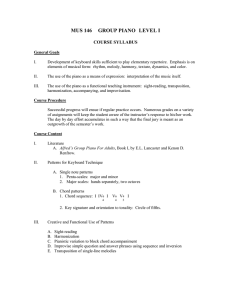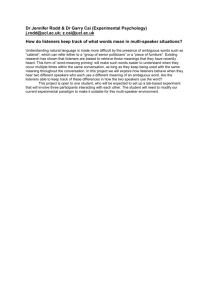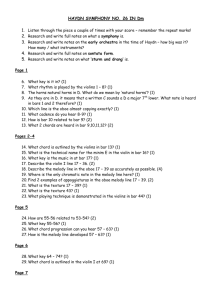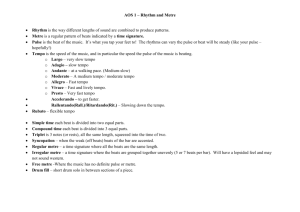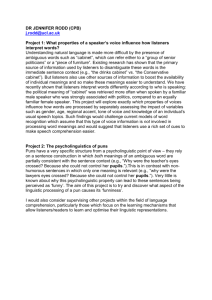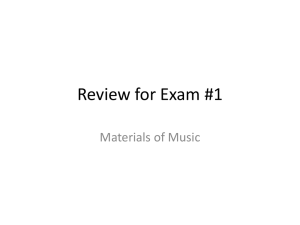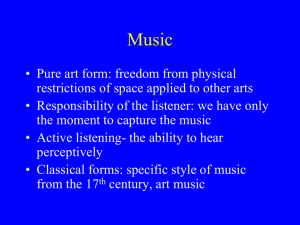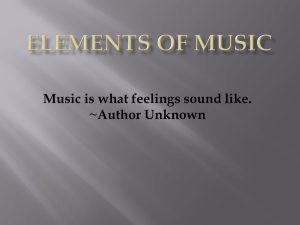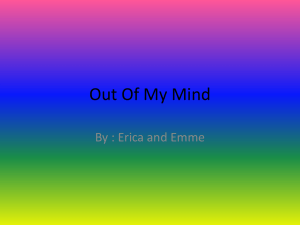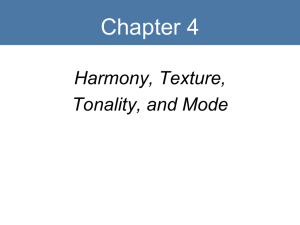Music
advertisement
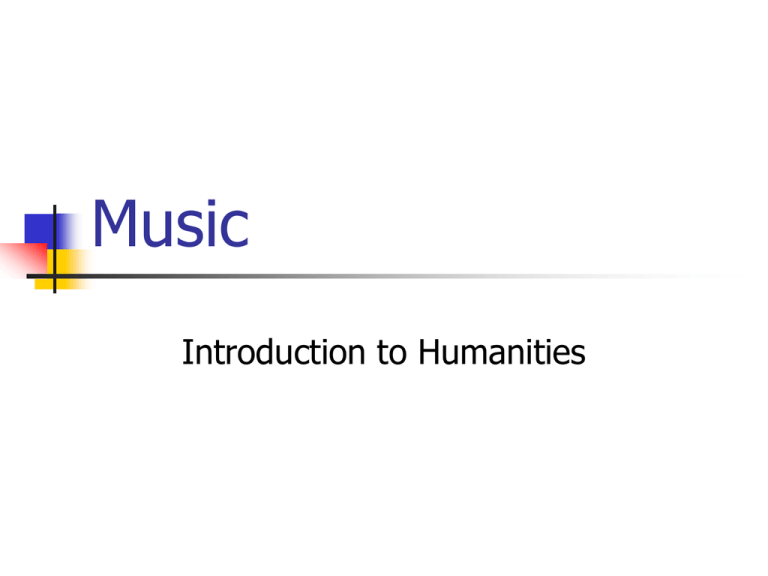
Music Introduction to Humanities Music chapter 9 Music is one of the most powerful of the arts partly because sounds – more than any other sensory stimulus – create in us involuntary reactions, pleasant or unpleasant. There is no escaping the effects of music except by turning off the source. HEARERS AND LISTENERS Music can be experienced in two basic ways: “hearing” or “listening.” Hearers, do not attempt to perceive accurately either the structure or the details of the form. They may hear a familiar melody which may trigger associations to their memory. Hearers and Listeners cont’d The listeners, conversely, concentrate their attention upon the form, details as well as structure. Listeners focus upon the form that informs, that creates content. Listeners do not just listen: they listen for something – the content. THE ELEMENTS OF MUSIC First important terms and concepts of music essential to a clear discussion. Tone: a sound that has one definite frequency or that is dominated by one definite frequency is a tone. Most music is composed of a succession of tones. Cont’d Consonance: when two or more tones are sounded simultaneously and the result is pleasing to the ear, the resultant sound is said to be consonant. For example, what sounds dissonant or unpleasant often becomes more consonant after repeated hearing. Also, there is the influence of context: a combination of notes may seem dissonant in isolation or within one set of surrounding notes and consonant within another set. Cont’d Dissonance: This unpleasantness is a result of wave interference and a phenomenon called “beating” which accounts for the roughness we perceive in dissonance. The most powerful dissonance is achieved when notes close to one another in pitch are sounded simultaneously. Terms Cont’d Rhythm: is a term referring to the temporal relationships of organized sounds. Rhythm marks when a given note is to be played, and how long it is to be played (its duration). Our perception of rhythm in a composition is also affected by accent or stress on given notes. Terms cont’d Tempo: is the speed at which a composition is played. We perceive tempo in terms of beats, just as we perceive the tempo of our heartbeat as seventy-two pulses per minute, approximately. Many tempos have descriptive names indicating the general time value. Terms cont’d Melody: is usually defined as a group of notes played one after another having a perceivable shape, or having a perceivable beginning, middle, and end. Usually a melody is easily recognizable when replayed. We not only recognize melodies easily but can say a great deal about them. Terms cont’d Counterpoint: by staggering the melodic lines as in folk songs such as “Row, Row, Row Your Boat,” this is called counterpoint A playing of one or more motives, themes, or melodies against each other. It implies an independence of simultaneous melodic lines, each of which can, at times, be most clearly audible. Terms cont’d Harmony: is the sounding of tones simultaneously. It is the vertical dimension, as with a chord (fig 9-2) as opposed to the horizontal dimension, with a melody. A chord is a group of notes sounded together that has a specific relationship to a given key: the chord C-E-G, for example, is a major triad in the key of C major. Terms cont’d Dynamics: one of the most easily perceived elements of music is dynamics: loudness and softness. Composers explore dynamics – as they explore keys, timbres, melodies, rhythms, and harmonic – to achieve variety, to establish a pattern against which they can play, build tension and release it, and to provide the surprise which can delight an audience. THE SUBJECT MATTER OF MUSIC Our theory identifies two basic kinds of subject matter: feeling (emotions, passions, and moods) and sound. It is difficult for music to refer to specific objects and events outside itself. Therefore it is difficult to think of music as having the same kind of subject matter as a representational painting, a figurative sculpture, or a realistic novel. FEELINGS The content of music is the interpretation of those feelings. Feelings are composed basically of sensations, emotions, passions, and moods. Any awareness of our sense organs, whether internal or external being stimulated is a sensation. Cont’d Emotions are strong sensations felt as related to a specific and apparent stimulus. Passions are emotions elevated to great intensity. Moods, on the other hand, are sensations that arise from no specific or apparent stimulus, as when one awakens with a feeling or lassitude or gloom. Brief Summary Music with its capacity to evoke feelings, and with a complexity of detail and structure that in many ways is greater than that of language, may be able to reveal or interpret feeling with much more precision than language. There is mystery about music, unique among the arts; that is part of its fascination. -30-
